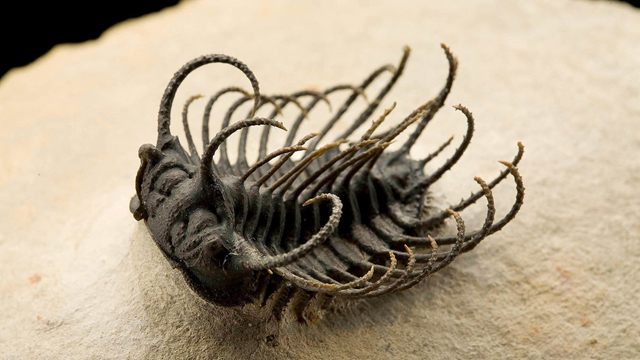Trilobites may be the archetypal fossils, symbols of an archaic world long swept beneath the ruthless road grader of time. But we should all look so jaunty after half a billion years.
At the Smithsonian’s National Museum of Natural History, Brian T. Huber, chairman of paleobiology, points to a flawless specimen of Walliserops, a five-inch trilobite that swam the Devonian seas around what is now Morocco some 150 million years before the first dinosaurs hatched. With its elongated, triple-tined head horn and a bristle brush of spines encircling its lower body, the trilobite could be a kitchen utensil for Salvador Dalí. Nearby is the even older Boedaspis ensifer, its festive nimbus of spiny streamers pointing every which way like the ribbons of a Chinese dancer.
In a back room of the museum, Dr. Huber opens a drawer to reveal a dark, mouse-size and meticulously armored trilobite that has yet to be identified and that strains up from its sedimentary bed as though determined to break free.

“A lot of people, when they see these fossils, don’t believe they’re real,” said Dr. Huber, who is 54, fit from years of fieldwork, and proud that the state fossil of his native Ohio is a trilobite. “They think they must be artists’ models.”
The fossils are real, and so, too, is scientists’ unshakable passion for trilobites (TRY-luh-bites), a diverse and illuminating group of marine animals, distantly related to the horseshoe crab, that once dominated their environment as much as dinosaurs and humans would later dominate theirs — and that still have a few surprises up their jointed sleeves.
In a series of recent reports, scientists describe fresh insights into the trilobite’s crystal-eyed visual system, unique in the animal kingdom, and its distinctive body plan, a hashtag of horizontal segments arrayed along three vertical lobes that allowed the trilobite to roll up into a defensive ball against predators and sea squalls.
Other researchers have found evidence that some trilobites were highly social, migrating long distances in a head-to-tail procession as they searched for food, or gathering together during molting season at a kind of Trilo’s Retreat, where the trilobites could simultaneously shuck off their carapaces and seek out mates.
“It looks like a lot of trilobite mating behavior happened when they were in a soft-shelled form,” said Carlton E. Brett, a professor of geology at the University of Cincinnati, who has presented research on trilobite assemblages to the Geological Society of America and elsewhere. “They did it in the nude.”
To investigate trilobite social life, Dr. Brett and his colleagues analyzed numerous examples of mass burial sites, where congregations of trilobites had been trapped in place by the sedimentary upheavals from violent sea storms, just as the residents of Pompeii were smothered in midscream by Vesuvian ash.
Source: New York Times
http://www.nytimes.com/2014/03/04/science/when-trilobites-ruled-the-world.html


